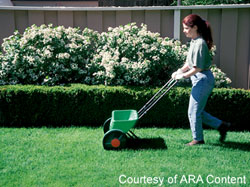 (ARA) - If you're concerned about our global environment, try taking better care of your own lawn -- how you take care of your lawn can make our world a cleaner place. Thick, healthy grass reduces erosion, filters pollutants, provides natural cooling and cleaner air. One of the keys to thick, healthy turf is to follow an annual fertilizing program.
"The greatest benefit of a healthy lawn is a well-developed root system, and a lawn that has been regularly fed requires less water than a lawn that hasn't been properly fertilized," says Nick Christians, Ph.D., an Iowa State University horticulturist.
According to Project EverGreen, a national alliance of lawn and landscape companies and associations created to educate and inform consumers about how to maintain and manage green spaces, it's important to follow best management practices when using fertilizer to help the lawn develop a strong root system, crowd out weeds, and decrease water runoff and soil erosion.
"Best management practices include carefully following label recommendations for timing and rate of application, as well as making sure the material is spread on the lawn and not on sidewalks and driveways," says Christians.
Start an annual fertilizing program by feeding the lawn at the same time as the first mowing of the year. The daytime temperatures should be between 60 to 80 degrees. After the first spring feeding, follow-up every six to eight weeks with the appropriate type of fertilizer for that time of year.
The optimum time to use fertilizer is during high-growth periods. This means most homeowners will fertilize four times a year: once in late-spring, again in early summer and twice during the fall (at the beginning and end of the season).
It's important to use lawn fertilizers the right way by following label instructions. Label instructions tell homeowners the correct spreader setting to use, whether grass should be damp or dry when the product is to be applied, and whether they should wait before mowing their lawn. Products are designed to do the best job when they are used as directed.
Fertilizer may be applied using a rotary spreader, a drop spreader or through an underground irrigation system. Drop spreaders are more precise and take a bit longer to use than rotary spreaders. No matter what type of application is used, it is important to sweep all particles off of hard spaces and back onto the lawn to prevent fertilizer from being washed down storm sewers into our waterways.
"Regular fertilization is so important to lawns. When lawns are thick and healthy, they prevent erosion and act as natural filters of pollutants," explains Rich Martinez, chief environmental officer of The Scotts Company, a member of Project EverGreen. "It is important to get the right amount of fertilizer in the right place on your lawn."
A nonprofit organization, Project EverGreen's mission is to educate the public about the value of green spaces and to encourage responsible practices among those who care for green spaces. For more information about Project EverGreen, visit www.projectevergreen.com.
Courtesy of ARA Content
|